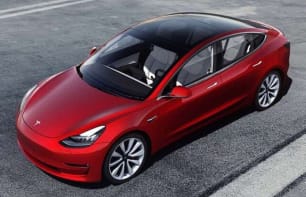Very occasionally, one drives a car that makes the human body feel inadequate to the task. I would have worried that I’m getting old, that my body is simply too flubby and my brain too broken, to cope with the kind of wild acceleration and brutal g-forces the Model 3 Performance delivers.
But, fortunately, I had a videographer in the passenger seat, a much younger man who loves fast cars, and he kept threatening to vomit when I drove it hard, too.
I’ve driven quite a few cars that you can use make your passenger sick, or hurt their necks - one obvious competitor in the shape of a Porsche Taycan Turbo S comes to mind - but it’s very rare that a vehicle is so intense it can make you, the driver, feel bilious.
Yes, you do bring this on yourself, by choosing to push this Performance anywhere near its limits through particularly sharp and intestine-shaped roads like the canyons outside Malibu Tesla chose to launch it on.
On longer, sweeping bends it was far more of a joy, and less physically punishing, but in the tight stuff it often felt like corners were being thrown at you, as if you were driving behind the Millennium Falcon and being pulled along in its wake.
The brakes, special new sporting ones with track-ready pads, were up to the task, even though it often felt like they couldn’t possibly pull you up from the speeds you were doing.
And yes, it was entirely my fault that the very first time I even gently prodded the throttle and it launched me ahead past a California Highway Patrol officer, that was my fault too. Three minutes into the drive, holding an American fine, I had already deduced that perhaps this car was too fast for my own good.
But lots of EVs are fast in a straight line, you’re really comparing the length and depth of your “oooophhh” sounds at this point, but where this one succeeds is by being a lot better in the handling and ride and cornering departments than most.
Tesla’s stated goal with this car was to move beyond straight-line speed, to become more than a one-trick pony, and to do that it’s given the Performance a stiffer structure overall and updated the springs and stabiliser bars.
Aerodynamic changes have reduced drag by five per cent, delivered a 36 per cent lift reduction, and a 55 per cent improvement in front-to-rear lift balance.
Tesla’s own, in-house version of adaptive dampers, not an option but included in every Performance, work with the car’s 'Vehicle Dynamics Controller' through its various modes - 'Insane' and 'Track' being the most… ludicrous - to immediately respond to driver inputs.
The Performance rides well on LA’s awful concrete freeways but feels absolutely nailed down when you attack even a bumpy driver’s road.
This version also has a lot more power going to the rear wheels, to help it feel more sports-car playful and to fire out of bends the way an enthusiast’s car should. And make no mistake, I met them, the people behind this car are serious driving enthusiasts (although they demur, slightly, on whether their boss is one).
Track mode will allow some serious adjustability, drifting ability and fun, so the kind of people who want to hurl around a racing circuit in silence will love it.
Perhaps the only let downs are that it still feels a bit austere inside, just not very special, and that the steering is just a bit digital, soft and uninvolving, compared to the cars they clearly benchmarked against - BMWs and Porsches.

